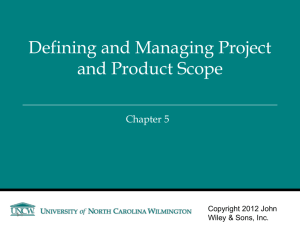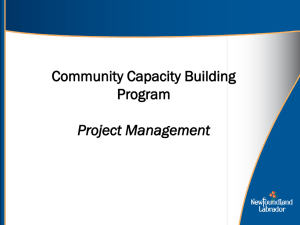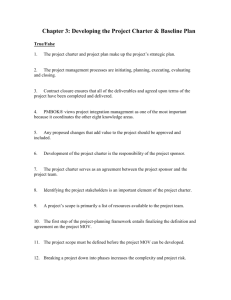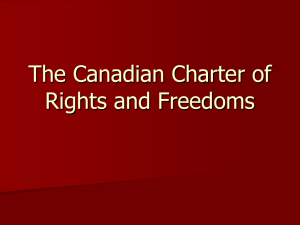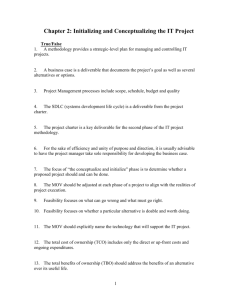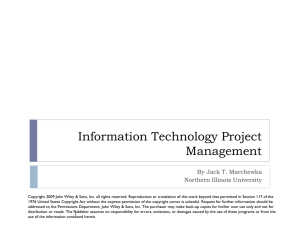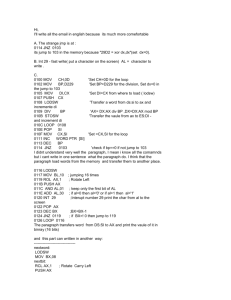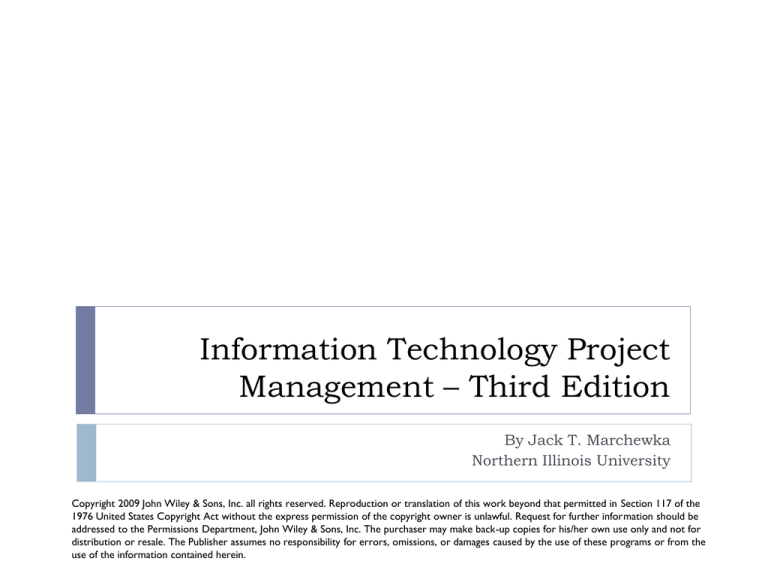
Information Technology Project
Management – Third Edition
By Jack T. Marchewka
Northern Illinois University
Copyright 2009 John Wiley & Sons, Inc. all rights reserved. Reproduction or translation of this work beyond that permitted in Section 117 of the
1976 United States Copyright Act without the express permission of the copyright owner is unlawful. Request for further information should be
addressed to the Permissions Department, John Wiley & Sons, Inc. The purchaser may make back-up copies for his/her own use only and not for
distribution or resale. The Publisher assumes no responsibility for errors, omissions, or damages caused by the use of these programs or from the
use of the information contained herein.
Developing the Project Charter &
Baseline Project Plan
Chapter 3
An IT Project Methodology
Figure 2.1
3
The Business Case has been approved,
but…
Who is the project manager?
Who is the project sponsor?
Who is on the project team?
What role does everyone associated with the project play?
What is the scope of the project?
How much will the project cost?
How long will it take to complete the project?
What resources and technology will be required?
What approach, tools, and techniques will be used to develop the
information system?
What tasks or activities will be required to perform the project work?
How long will these tasks or activities take?
Who will be responsible for performing these tasks or activities?
What will the organization receive for the time, money, and resources
invested in this project?
4
PMBOK - Definition
Process
A set of interrelated actions and activities that are performed
to achieve a pre-specified set of products, results, or services
5
Projects versus Processes
Processes are ongoing
If you’re building cars on an
assembly line, that’s a
process!
If you’re designing and building
a prototype of a specific car
model, that’s a project!
6
Project Management Processes
Project Management processes
Help initiate, plan, execute, monitor and control and close a project
as well as interact with the project management knowledge areas
e.g., develop a business case, develop an MOV
Ensures that the final product meets the exoectations of the intended
client
A caterer hired to bake a wedding cake, would need project management
processes to define, plan, estimate the cost and deliver a cake that meets
the customer’s expectations, budget and needs while being profitable to
the caterer
Product-Oriented processes
Development processes that focus on tangible results of the
project – develop a quality product
For an IT project this would include all the processes to design, build, test,
document and implement an application system
7
Project Management Processes
The PM must find the balance between the two
Figure 3.1
8
Project Integration Management
Integration, in the context of managing a project, is
making choices about where to concentrate resources
and effort on any given day, anticipating potential
issues, dealing with these issues before they become
critical, and coordinating work for the overall project
good. The integration effort also involves making tradeoffs among competing objectives and alternatives.
(PMBOK guide)
9
Project Integration Processes
Develop Project Charter
Develop Preliminary Scope Statement
Corrective/preventive actions/defect repair/rework
Integrate Change Control
Project work is carried out
Monitor and Control Project Work
How the project will be executed monitored, controlled and closed
Direct & Manage Project Execution
First draft of what the project must deliver
Develop Project Management Plan
A project cannot be started without a project charter
Manage change
Close Project
Administrative and contractual closure
10
The Project Charter
Together with the baseline project plan, provides a tactical
plan for carrying out the project
Serves as an agreement or contract between the project
sponsor and team
Provides a framework for project governance
11
The Project Charter
Documents the project’s MOV
Defines the project infrastructure
Specify lines of reporting and those responsible for specific decisions
Shows explicit commitment to the project
Summarize the scope, schedule, budget, quality objectives, deliverables and
milestones
Defines roles & responsibilities
Details everything needed to carry out the project
Summarizes the details of the project plan
At this point it is finalized and agreed upon by all
Identify project sponsor and who takes ownership of the finished product
Sets out project control mechanisms
Outline a process for requesting and responding to change
12
What Should Be in a Project Charter?
Project ID
name identification (SABRE – semi-automated business research environment)
Project Stakeholders
Project Description
MOV
Project Scope – specify what will NOT be done as well
Project Schedule (summary)
Project Budget (summary)
Quality issues/standards/requirements
Resources
Assumptions & Risks
Project Administration
Acceptance & Approval
References
Terminology (acronyms & definitions)
13
Project Charter Template
14
Project Plan
A Project Plan attempts to answer the questions
What needs to be done?
Who will do the work?
When will they do the work?
How long will it take?
How much will it cost?
15
Project Planning Framework
A Project Plan attempts to answer the questions
What needs to be done?
Who will do the work?
When will they do the work?
How long will it take?
How much will it cost?
The project planning framework is part of the IT project
methodology and provides the steps and processes necessary to
develop the detailed project plan that will support the project’s MOV
Figure 3.4
16
Project Planning Framework
The MOV
Defined and agreed upon
MOV acts as a bridge between the strategic mission of the
organization and the project plans of individual projects it
undertakes
Define the Project’s Scope
Planning
Definition
Verification
Change Control
17
Project Planning Framework – cont’d.
Subdivide the Project into Phases
Once the scope is defined and verified, the work can be
organized into phases and subphases in order to complete all the
deliverables
Tasks-Sequence, Resources, and Time Estimates
A task is a specific activity or unit of work to be completed
Each phase should focus on one deliverable
Sequence – linear or parallel
Resources – tasks require resources and there is a cost associated with
each resource
Time
Schedule and Budget-The Baseline Plan
Once the project plan is approve, it becomes the baseline plan that
serves as a benchmark to measure the project’s actual progress
18
The Kick-Off Meeting
Officially starts the work on the project
Brings closure to the planning phase
Communicates to all what the project is about
Energizes stakeholders
Engenders positive attitudes
19

